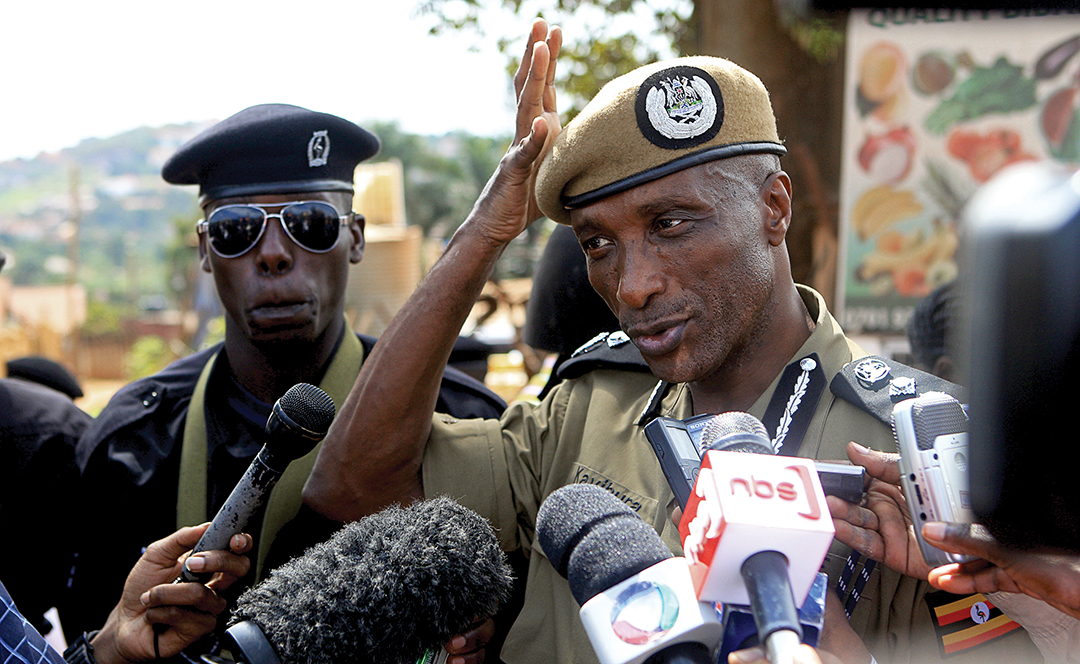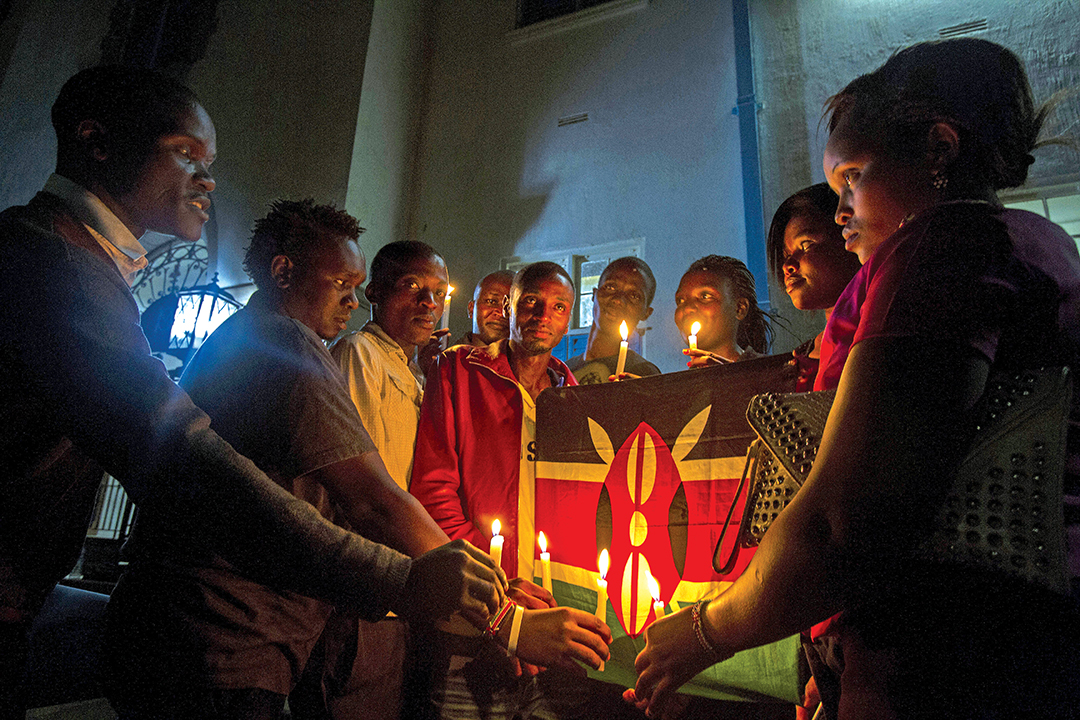African Union Forces Must Use Counternarratives to Unravel Al-Shabaab’s Recruitment Messaging
BY LT. Col. DEO AKIIKI, UGANDAN MINISTRY OF DEFENCE
Lt. Col. Deo Akiiki is head of strategic communications at the Uganda Ministry of Defence. He has led military information support operations to defeat al-Shabaab propaganda. He is an expert in crafting strategies to counter extremist narratives in print and electronic media. He holds a master’s degree in human rights and local governance from Uganda Martyrs University, and he graduated from the Marshall Center’s Program on Applied Security Studies. This article has been edited to fit this format.
As a military officer who has spent the better part of his career in communications and information management and served in operations in Uganda and Somalia — where the African Union (AU) has fought to defeat al-Shabaab for close to 10 years — I have seen tremendous efforts put forth to fight terrorism. It is high time that information operations — and indeed counternarratives — are given priority as a powerful weapon to deal with terrorism.
The East African region has been a hot spot for terrorist activities. Some of the terror groups in the region include al-Qaida, al-Shabaab, the Allied Democratic Front, the Lord’s Resistance Army, al-Ittihad al-Islamiyah and al-Muhajiroon. All of these groups use narratives as their weapons of choice. These narratives target citizens in East Africa, the East African diaspora, the terrorists’ own forces and disengaged terrorist fighters.
Terrorists’ strength emanates from how, when and what they communicate to their target audiences. There are numerous examples in which terrorists have recruited and mentored their fighters through the power of information operations. In Barawe, Somalia, an American-born terrorist confessed to being recruited online. Additionally, over the past 10 years, captured al-Shabaab members have confessed to believing al-Shabaab narratives, leaving them blind to alternative or contradictory information.

Military commanders must accept that terrorists have been playing this game successfully for a long time. It is time that the information war is seriously reconsidered. The Somali conflict is a contest of wills that has taken place in Somali minds as much as on the battlefield. Most terrorist acts are committed based on this ideological foundation that al-Shabaab has fostered, which makes extremist acts seem righteous.
To counter such a phenomenon, the African Union Mission in Somalia (AMISOM) must not only attack and degrade al-Shabaab leadership and capabilities, but also delegitimize and counter the appeal of al-Shabaab ideology. This requires addressing the underlying conditions that terrorists exploit to spread extremist ideology.
For AMISOM and the Somali National Army to continue shaping current peace enforcement operations in Somalia, public perception must also be shaped. Counternarrative campaigns designed to convey messages to target audiences and promote themes that will result in desired attitudes and behavior will go a long way in the fight against terrorism.
Terrorist Narratives
Terrorist narratives may appear implausible, but because they are tailor-made for individuals that have little alternative information, they are believed. Let’s look at just a few of the lies they spread:
The need to reverse marginalization of Muslims: Terror groups have worked hard to propagate the notion among the Muslim community that they are marginalized by the central government. Every government action must consider the impact on the Muslim community or else it is worthless.
The need to establish an Islamic state: They continue to assure their adherents of victory and heavenly rewards. This, they say, can only be attained through a regional Islamic state that is pure.
The need to defeat “the Satanic Western” influence: Terrorists say that Western powers are exploitative and manipulative, thus the need for militant groups to fight for the sovereignty of their states.
Targets in Somalia
Over the years, al-Shabaab terrorists have aimed their messages at certain audiences in Somalia, using the internet as a weapon to stream their activities in real time and post misleading information.
Their efforts mostly mobilize action against the so-called infidels, who in this case are AU troops from non-Muslim countries. The language used is supposed to portray a religious fight. They divert the audience’s attention from the heinous acts by focusing on an appealing subject. Such a narrative takes nonkinetic efforts to defeat. To dilute terrorist messaging, counternarratives should be well-crafted and circulated in equal measure or beyond what the terrorists have done.
To a large extent, al-Shabaab has succeeded in portraying AMISOM as an occupying force. No country or individual would feel comfortable with foreigners occupying their territory. Countries that have been occupied have sacrificed all they could to rid their land of foreign forces. Such an allegation was readily consumed by al-Shabaab’s audiences and, indeed, did damage to the legitimacy of AMISOM forces in the minds of the Somali people and the diaspora.
Narratives that focus on recruitment of local and foreign fighters, especially using online platforms, have been the norm and the easiest method of attracting potential fighters. Today, young people use social media in large numbers. Consequently, they are most targeted by terrorists.
In a bid to control and refocus the minds of their troops, terrorists — especially al-Shabaab in Somalia — have not spared their own forces from their propaganda machinery. They promise heavenly rewards such as those promised in holy teachings and encourage them to fight to restore Islam. Recruits are encouraged to fight and defeat Western influence and are shown fake examples of success to boost their morale. This, to a large extent, keeps fighters fighting for what is assumed to be a “just” cause.
Those who have disengaged from terrorist activities, were captured or have surrendered are labeled as traitors. They and their families are threatened with painful death. Such threats have discouraged former terrorists, kept them in hiding, or left them in fear for their lives instead of reintegrating into society or participating in the fight against terrorism.
AMISOM and government troops and other participating forces, not only in Somalia but across the world, have been targets of terrorists’ propaganda. African peacekeepers and governments are depicted as tools of Western nations rather than liberators fulfilling their pan-African responsibility. They are labeled as occupying forces, encouraging troops to look at their leaders and governments as selfish and fighting for an unjustified cause. In such a situation, if troops are not well-grounded and briefed, it may affect their morale and favor their adversaries.

Captures and fake defections have also been used to portray the terrorists as victorious, and even when such incidents occur, their numbers are exaggerated and widely circulated to damage morale, discourage troops and their commanders, or even erode the will of participating countries so that they might consider withdrawing their contingents. It’s no wonder that whenever AMISOM troops cause a significant number of deaths in Somalia fighting al-Shabaab, the first narrative from the media and other platforms is a call for the withdrawal of coalition troops. This line of reasoning comes from al-Shabaab propaganda and not from the home countries of the contributing troops.
Defeating the narratives
As global actors against terrorism, we need to fully use the media and engage in all debates, foster community engagement, and discover new ways of countering terrorist narratives. Carefully selected speakers should deny the terrorists their information monopoly over their target audience.
The following are suggested techniques to be used with AMISOM concepts of operation to counter al-Shabaab psychological operations. They can be used individually or in combination, depending on careful analysis and factual information about al-Shabaab and those living in areas controlled by them. For example, it is important to determine the populace’s general perception of al-Shabaab, as well as the perception of the Somali government and government/AMISOM cooperation to craft a persuasive message.
- Serious point-by-point rebuttals of terrorist narratives must be displayed online and by other means to completely discredit the message and, by implication, other messages originating from the source. Messages should be crafted so that the audience’s attention is swayed away from the issues raised by terrorists.
- Insulate citizens from outside influences by preconditioning them against indoctrination. This way they will automatically dismiss messages from terrorists.
- Efforts to reach foreign terrorist fighters need to focus on legal, religious, social, diplomatic and other arguments. Based on the capabilities and resources available, terrorist narratives can easily be countered to reorient people and neutralize propaganda.
Finally, countering terrorism is a “war” characterized by ideas, perceptions and the mind. We often think the narratives of terrorists have been a decisive weapon for their side. These narratives are the competing storylines that, as a small country, we have attempted to counter at home in Uganda and while fighting terrorism across most of the region.
Global cooperation in countering these narratives can degrade the terrorists’ power to justify indiscriminate violent tactics, propagate radical ideologies, and win over new recruits and sympathizers. We should never cede territory on this ideological battlefield.

